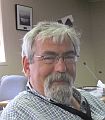FLASHBACK TO 2010: Release of “Re-Inventing Rainwater Management in the Capital Region” was announced at the Bowker Creek Forum by Calvin Sandborn, Legal Director of the Environmental Law Clinic, University of Victoria

“It was both timely and relevant that the UVIC Environmental Law Clinic released Re-Inventing Rainwater Management on the same day that the Bowker Creek Forum was held at UVic. The day forced us to ‘think watershed’ and transcend jurisdictional boundaries. The politicians are listening. Geoff Young, CRD Chairman, stated that ‘cross boundary problems make managing rainwater more difficult, but some of the ideas they have put forward are ones we have started talking about’,” stated Eric Bonham.










